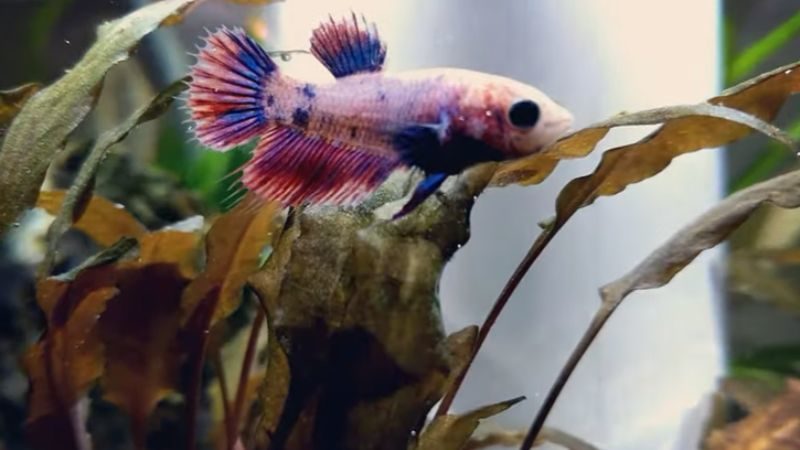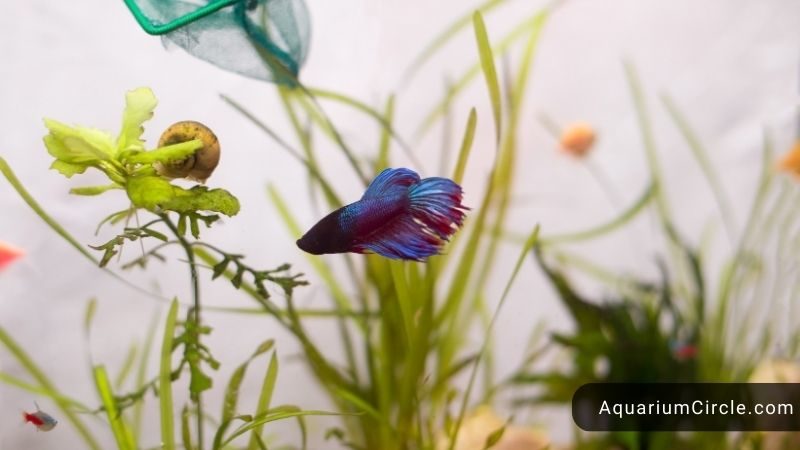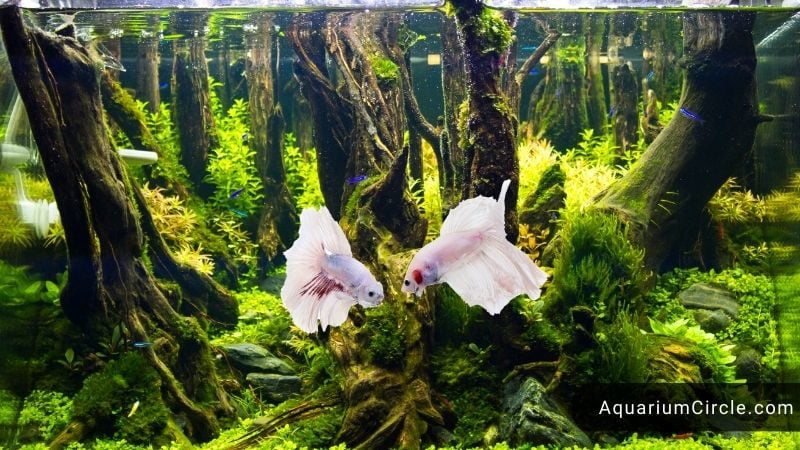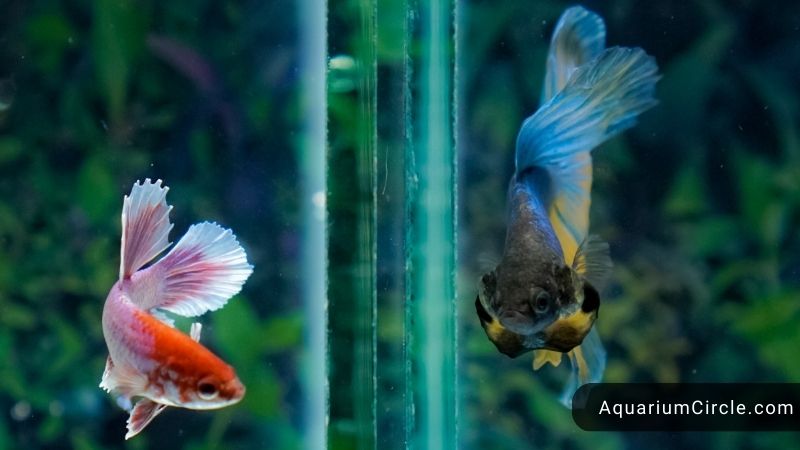Betta fish frequently experience clamped fins, which can have an impact on their general health. It can be a sign that something is wrong when a Betta’s fins appear clamped or held close to its body. To guarantee the health and pleasure of the fish, it is crucial to comprehend the reasons for clamped fins in Betta fish and available treatments. This article will tell you some helpful information that you should know about clamped fins betta.
What Is Clamped Fins Betta?
The term “clamped fins” refers to how your betta’s fins are held close to its body. Clamped fins are not only an indicator of a problem, but a problem in general. Indeed, there are various other reasons why your betta has clamped fins.
So, it’s crucial to determine the actual cause of your betta’s clamped fins before taking any action to treat them.
What Are The Symptoms Of Clamped Fins Betta?
How do you know your bettas have clamped fins? Various underlying health problems, including bacterial infections, parasite infestations, or low water quality, are linked to clamped fins.

You might also notice various additional physical symptoms of disease in betta fish, depending on the precise underlying cause of clamped fins. For example, the fins of betta fish are interlocked. Bettas frequently enjoy showing off their lovely fins, especially when they can see their reflections or when there are other bettas nearby. Even if they don’t always fan out their fins, if they do, it’s a sign that something is wrong if they do so all the time.
What Are Causes Of Clamped Fins Betta?
Betta’s fins are clamped usually means that something went wrong during the caregiving process. Yet, sometimes, a common cause of curled fins can also occur from a non-reversible process, such as aging.
Trauma
Don’t you think that the betta fish tank is their safest home? So what can cause trauma to them?
Aggressive fish personalities and fierce protection of their swimming areas. Fights and injuries aren’t at all unusual if you have a Betta-centric tank with more than one Betta male. Bettas typically attack the fins first because they are easy targets when they fight. After all, they are weaker than the body.
Bettas can hurt themselves by flying from one end of the aquarium to the other, especially if there are any sharp-cornered ornaments present. For instance, a Betta’s fragile fins are readily injured or bruised by rock formations with sharp edges.
Low-quality water

There are 2 types of low-quality water, hard water, and low water temperature.
Although the term “hard water” may seem absurd, it refers to measuring the number of minerals in the water. It has a loose connection to pH levels. Hard water often has a higher pH level and a greater concentration of dissolved minerals. Soft water, on the other hand, denotes a low mineral content and a lower pH level.
When it comes to water change, bettas prefer a level that is between 5 and 20dH. It’s better to stay in the middle of that range for the greatest results and to protect your fish. Your betta’s fins may curl if the water hardness level starts to rise above 20dH. High water hardness levels can stress fish and, in difficult situations, result in mortality, which harms their general health. Using your water parameters carefully to avoid poor water conditions.
Every fish species is distinct from another in that it has particular clean water needs. Fish may thrive in water that is 77 to 81 degrees Fahrenheit warmer. There will be no zero ammonia.
Others
There are some other causes that you should keep in mind. Check the list below:
- Congenital problems.
- The old age.
- Stress.
- Hostile tank mates.
- Diseases.
- Uncomfortable tank.
- Shock.
- Genetic disorder.
How To Treat Clamped Fins Betta?
Clamped fins on betta may be under stress, ill, or in bad water. It’s critical to determine and treat the underlying cause of clamped fins.
Improving the quality of water
Water softeners are the most widely used solution for aquarium water hardness. There are several brands on the market, but for the best results, we suggest consulting an aquarium specialist. As a fish keepers, always remember to keep an eye on nitrite levels as you work to reduce water hardness. As we have mentioned, the two are frequently connected, so lowering hardness might also lower pH.
You shouldn’t use tap water for nurturing the betta fish or all kinds of fish too. You can think tap water is clean, but in fact, it has poor water quality.
Adjust the best temperature.
To avoid clamped fins in bettas, you need a dependable thermometer positioned away from the heater to measure the water’s general temperature in the tank to determine whether clamped fins are brought on by your water temperature.
If the temperature falls outside of the 78-81 Fahrenheit range, turn the heater’s thermostat dial to bring it back into range, then recheck the thermometer after an hour. After the water temperature is consistently within the appropriate range, make little adjustments.
Let betta fish alone.

It isn’t much you can do if you think fins in bettas have curled owing to an injury. Of course, a trip to a licensed aquatic vet is necessary to aid in the healing of the wound and guarantee that it doesn’t become infected.
Several male bettas should never be kept in the same tank. That’s because they’re aggressive and territorial, which means fights among them are inevitable. Do not forget that the species is called the Siamese Fighting Fish for a reason.
Cure diseases and avoid infections
If an infection is betta fish fin rot, it must be treated immediately for the greatest results. By putting your betta in its hospital tank, gradually raising the water temperature for this tropical fish, and administering liquid meds, you may cure parasitic infections like ich at home.
Antibiotics are the most effective approach to treating bacterial infections, but they are not always accessible without first seeing a veterinarian.
Constipation, dropsy, and swim bladder issues are frequently addressed with an Epsom aquarium salt bath or by clearing the digestive tract by feeding the patient blanched peas.
See hơ to use salt bath here:
How To Prevent Clamped Fins Betta To My Pet?
Besides all the things that I mentioned about the tank’s water conditions can clamp its fins, and you should adjust the suitable indexes when keeping your betta.
Bettas are inquisitive, clever fish that require a lot of mental and physical stimulation. Give your pet plenty of toys, plants, decorations, and bits of driftwood to keep him occupied and interested. Many betta fish take pleasure in playing games and participating in interactive training sessions with their owners. As a result, we urge you to get your pet a variety of toys to keep them occupied.
You can stress your betta if you give it the wrong food. If you have a dependable supply, feed your betta fish a diversified, high-protein diet that consists primarily of meaty proteins in the form of frozen meals and live foods. The remainder of your pet’s diet should be made up of betta pellets.
FAQs
Can baby betta fish have clamped fins betta?
The causes of your newborn betta’s clamped fins may be related to those mentioned above. As a result, be sure to check the water’s pH, ammonia, nitrites, and nitrates, as well as its temperature. Also, you can lessen the stress your baby is experiencing by adding salt to the tank for your betta.
What does clamped fins betta look like?
Clamped fins of a betta are technically a sign of underlying illnesses or unhealthy tank conditions. The captivating, fluttering fins that make betta fish so alluring clamp up and may coil inward without fanning out when this occurs. An interesting way of putting it is by pointing out how clamped fins may appear to have been coated with oil and forced to adhere to one another.
Can clamped fins betta cause losing colors?
Change of color is another traditional sign of ill health in betta fish, similar to clamped fins. When a betta’s environment isn’t ideal, when they’re scared or shocked, or when they have an infection, loss of color frequently coexists with clamped fins.
References:
- Illness and cures – https://betta-fish.fandom.com/wiki/Illnesses_and_cures
- Siamese fighting fish – https://en.wikipedia.org/wiki/Siamese_fighting_fish

Annette M. Chaney is an experienced marine biologist with over 20 years of experience as an aquarist and fishkeeper. She started her first aquarium at a young age, filling it with frogs and goldfish obtained from the ten-cent pet store.
Annette grew up caring for and breeding African Cichlids, which led to a hobby in high school that doubled as a profitable means. Attending Reed College gave her time to solidify herself as an accomplished aquarium caretaker with an eye for sales. After that, from 2009 – 2013, she studied at Roger Williams University – one of the most prestigious universities for Aquaculture and Aquarium in USA. She is the founder of AquariumCircle since 2010.
